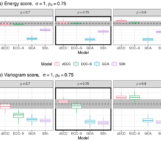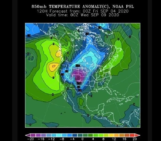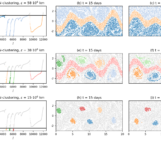
This month the NPG Paper of the Month award is achieved by Achim Wirth for his paper “Empirical evidence of a fluctuation theorem for the wind mechanical power input into the ocean“.
Achim obtained his PhD at the University of Nice (Franc), doing research on turbulence theory. He then moved to oceanography working at UCLA (USA) and Geomar (Germany). Since 2005 he holds a permanent position at CNRS working in the LEGI laboratory at the Université Grenoble Alpes (France). From 2014 to 2019 he was director of LEGI. His recent research is on applying methods of non-equilibrium thermodynamics to air-sea interaction.
Today, fluctuations are the focus of research in statistical mechanics, which was traditionally concerned with averages. Fluctuations in a thermodynamic system usually appear at spatial scales which are small enough so that thermal, molecular, motion leaves an imprint on the dynamics as first considered by Albert Einstein. The importance of fluctuations is, however, not restricted to small systems. Fluctuations can leave their imprint on the dynamics at all scales when (not necessarily thermal) fluctuations are strong enough.
In non-equilibrium statistical mechanics, which describes forced-dissipative systems, as air-sea interaction and many other components of the climate system, there is no universal probability density function (pdf). Some such systems have recently been demonstrated to exhibit a symmetry called a fluctuation theorem (FT), which strongly constrains the shape of the pdf.
FTs have been established analytically for Langevin type problems with thermal fluctuations. Most experimental data comes also from micro systems subject to thermal fluctuations. The thermodynamic frame of the quantities considered, as entropy, heat and work is not necessary to establish FTs. Examples of non-thermal fluctuations are the experimental data of the drag-force exerted by a turbulent flow and the local entropy production in turbulent Rayleigh-Bénard convection. For these non-Gaussian quantities the existence of a FT was suggested empirically. Our work, based on observations of atmospheric winds and oceanic currents, is strongly inspired by these investigations of the FT in data from laboratory experiments of turbulent flows.
The ocean dynamics is predominantly driven by the shear-stress between the atmospheric winds and ocean currents. The mechanical power input to the ocean is fluctuating in space and time and the atmospheric wind sometimes decelerates the ocean currents. Building on 24-years of global satellite observations, the input of mechanical power to the ocean is analysed. A Fluctuation Theorem (FT) holds when the logarithm of the ratio between the occurrence of positive (when the ocean gains energy by air-sea interaction) and negative events (when the ocean looses energy by air-sea interaction), of a certain magnitude of the power input, is a linear function of this magnitude and the averaging period. The flux of mechanical power to the ocean shows evidence of a FT, for regions within the recirculation area of the subtropical gyre, but not over extensions of western boundary currents. A FT puts a strong constraint on the temporal distribution of fluctuations of power input, connects variables obtained with different length of temporal averaging, guides the temporal down- and up-scaling and constrains the episodes of improbable events.




